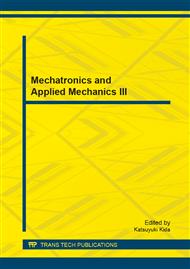[1]
Jannes Slomp, Boppana V. Chowdary, Nallan C. Suresh. Design of virtual manufacturing cells: a mathematical programming approach[J]. Robotics and Computer-Integrated Manufacturing 21(2005)273–288.
DOI: 10.1016/j.rcim.2004.11.001
Google Scholar
[2]
Gert Nomden, Durk-Jouke van der Zee. Virtual cellular manufacturing: Configuring routing flexibility. Production Economics112(2008)439 – 451.
DOI: 10.1016/j.ijpe.2007.04.010
Google Scholar
[3]
Gert Nomden · Jannes Slomp · Nallan C. Suresh. Virtual manufacturing cells: A taxonomy of past research and identification of future research issues. Flex Manuf Syst 17(2006)71–92.
DOI: 10.1007/s10696-006-8122-1
Google Scholar
[4]
J Aksoy, Asli, Oztürk, Nursel. Simulated annealing approach in scheduling of virtual cellular manufacturing in the automotive industry[J]. International Journal of Vehicle Design, 2010(52): 82-95.
DOI: 10.1504/ijvd.2010.029637
Google Scholar
[5]
Chen mang. Group scheduling simulation procedures and the bottleneck of manufacturing unit based on two phase[J]. Group technology and production modernization, 2011, 28(1): 16-23.
Google Scholar
[6]
Renna, Paolo. Multi-agent based scheduling in manufacturing cells in a dynamic environment[J]. Source: International Journal of Production Research, 2011(49): 1285-1301.
DOI: 10.1080/00207543.2010.518736
Google Scholar
[7]
K. L. MAK, J. S. K. LAU, X. X. WANG. A genetic scheduling methodology for virtual cellular manufacturing systems: an industrial application[J]. International Journal of Production Research, 2005, 43(12): 2423-2450.
DOI: 10.1080/00207540500046020
Google Scholar
[8]
Liu Haoguang, Cai Shaohong, Zhang Yuqiang, et al. Comparison of [J]. complex network model and several extended model BA Journal of Guizhou University: Natural Science Edition, 2007, 24(5): 473-474.
Google Scholar
[9]
PEARL J.Probabilistic reasoning in intelligent systems:networks of plausible inference[M].San Mateo, CA:Morgan Kaufmann, 1988.
Google Scholar
[10]
Jon T. McCloskey, Robert J. Lilieholm, Christopher Cronan. Using Bayesian belief networks to identify potential compatibilities and conflicts between development and landscape conservation. Landscape and Urban Planning 101 (2011) 190–203.
DOI: 10.1016/j.landurbplan.2011.02.011
Google Scholar
[11]
Gao-Xia W, Yi S. Module matrix and its community structure of the target network [J]. Journal of Physics, 2010, 59(2): 842-850.
Google Scholar
[12]
Wang Jianwei, Rong Lili, Yu Kai. Scale network evolution model [J]. Journal of system engineering, no node based on batch 20102010, 25(5): 581.
Google Scholar
[13]
Gao-Xia W, Yi S. Modularity matrix of networks and the measure of community structure[J]. (2010).
Google Scholar


